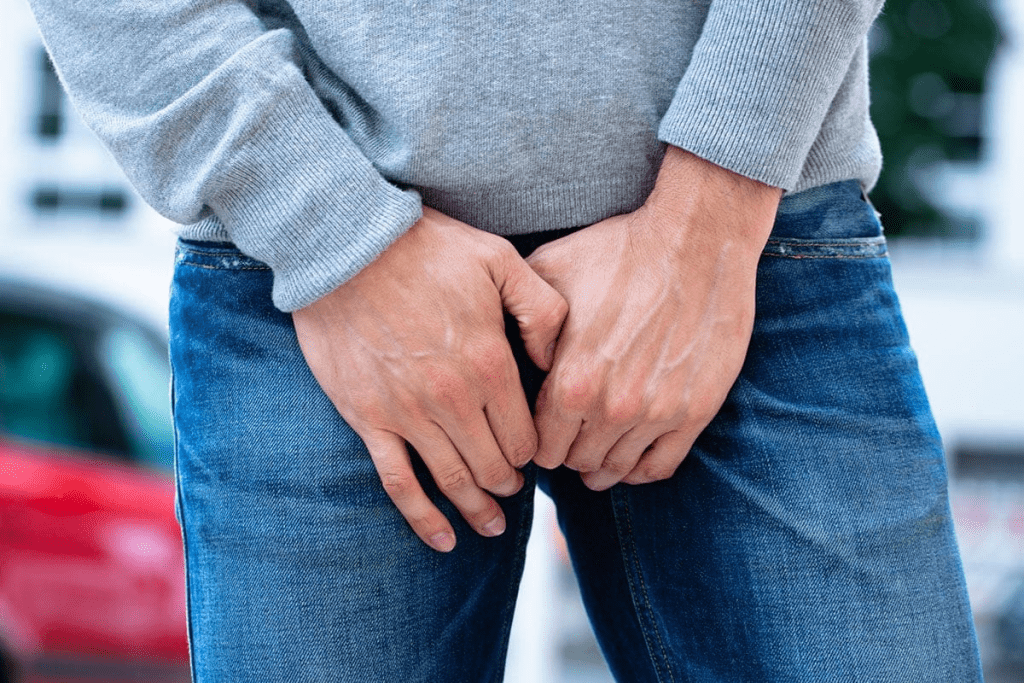Last Updated on November 25, 2025 by

Many people wonder if Peyronie’s disease can cause testicular pain. Peyronie’s disease symptoms usually affect the penile shaft’s connective tissue. These symptoms can lead to penile curvature or pain during erections.
Recent studies show that peyronie’s disease symptoms often include penile pain, mainly during the active phase. But, testicular pain is rare. The pain from Peyronie’s usually stays in the penis or perineum, not the testicles.
It’s important to understand peyronie’s disease symptoms well for good patient care. By recognizing these signs early, doctors can guide proper treatment. We’ll look into how Peyronie’s disease affects men’s health and the wide range of peyronie’s disease symptoms patients may experience.
Peyronie’s disease is a condition that affects men’s health. It impacts sexual function and overall well-being. Knowing its causes and peyronie’s disease symptoms is key.
Peyronie’s disease causes scar tissue in the penis, leading to curved, painful erections. The exact cause is not known. But, it’s thought to come from penis trauma or injury.
Trauma to the penis is a main risk factor. Genetics might also play a part, and both can increase the likelihood of noticeable peyronie’s disease symptoms over time.
The main symptom is a noticeable curvature of the penis. This can be very distressing. Other peyronie’s disease symptoms include erectile dysfunction and painful erections.
Men may also notice lumps or plaques in the penis. There could be a loss of girth or length. These peyronie’s disease symptoms can affect men’s sexual health and confidence.
Peyronie’s disease affects many men. The prevalence ranges from 0.5% to 20%. It mostly hits men aged 40 to 70.
But, peyronie’s disease symptoms can start as early as the 20s. Knowing who is most at risk helps in providing support and treatment.
Understanding the pain linked to peyronie’s disease symptoms is key to managing its effects. This condition can cause a lot of discomfort. It affects not just sex but also overall health.
Peyronie’s disease involves the growth of scar tissue inside the penis. This scar tissue, or plaque, can make the penis curve or bend. This bending leads to one of the most distressing peyronie’s disease symptoms ” pain during erections.
The pain from peyronie’s disease symptoms can differ in how sharp or dull it is. Some men might feel sharp pain during erections. Others might feel a dull ache even when their penis is soft.
The pain can be in one spot or spread out. Here are some common pain patterns linked to peyronie’s disease symptoms:
The stable phase has less inflammation and plaque stability. Pain can occur, but it’s usually less severe than in the active phase of peyronie’s disease symptoms.
“The pain associated with Peyronie’s disease can be quite debilitating, affecting not just sexual function but overall quality of life.” “ Clinical experts note.
A key part of peyronie’s disease symptoms is a palpable lump or plaque in the penis. This lump can cause discomfort and pain, more so during erections or when the penis is touched. Recognizing these peyronie’s disease symptoms early helps patients seek timely treatment and improve quality of life.

The discomfort from the lump can vary. Some men feel pain directly from the lump. Others might feel more general discomfort.
Dealing with Peyronie’s disease can be tough. By knowing the symptoms and how pain relates to Peyronie’s disease, men can get the right medical care. This helps manage their condition better.
It’s important for men to understand if Peyronie’s disease can cause testicular pain. Peyronie’s disease leads to curved erections and painful sex due to scar tissue in the penis. But, can it also cause pain in the testicles?
Most studies on Peyronie’s disease focus on its effects on the penis. They show that Peyronie’s disease can be very painful. But, direct testicular pain is rare in men with this condition. A study in the Journal of Urology found that pain from Peyronie’s disease usually affects the penis or perineum, not the testicles.
The anatomy of the penis and testicles helps explain why testicular pain is rare with Peyronie’s disease. Peyronie’s disease affects the tunica albuginea of the penis, causing plaque and curvature. The testicles, being separate, are usually not affected by Peyronie’s disease. So, men with Peyronie’s typically don’t feel pain in their testicles.
Some men with Peyronie’s disease might feel discomfort or pain during ejaculation. This symptom is not directly caused by Peyronie’s disease affecting the testicles. It could be related to the sexual dysfunction caused by Peyronie’s disease. A study in the European Urology journal says pain during ejaculation can be a symptom of many urological conditions. Men with this symptom should see a healthcare provider to find out the cause and get the right treatment.
In summary, Peyronie’s disease mainly affects the penis, causing curvature and pain. But, direct testicular pain is rare. Men with testicular discomfort or pain during ejaculation should get a medical check-up to find the cause and get the right treatment.
Testicular pain can come from many sources. Knowing these alternatives is key for the right diagnosis and treatment. Peyronie’s disease is a big worry for many men. But, other conditions can also cause similar pain, so it’s important to look at a wide range of possible causes.
IMAGE TO BE CORRECTED
Many health issues can lead to testicular pain or discomfort. These are often mistaken for Peyronie’s disease. Some of these include:
These conditions can cause a lot of discomfort and need proper diagnosis and treatment.
Prostate issues, like prostatitis or benign prostatic hyperplasia (BPH), can cause pain or discomfort in the genital area. Sexual dysfunction, including premature ejaculation, can also be related to or confused with Peyronie’s disease symptoms. It’s important to understand how these conditions interact for effective management.
Prostate problems can lead to symptoms such as:
Testicular torsion is a medical emergency where the spermatic cord twists. While ejaculation itself is not a direct cause, vigorous sexual activity might trigger torsion in some. But, torsion is more often linked to anatomical issues or trauma.
If you have sudden, severe testicular pain, seek medical help right away. Quick action is key to saving the affected testicle.
Understanding Peyronie’s disease and its symptoms is key to managing it well. Peyronie’s disease can really affect a man’s life, causing pain and discomfort. We’ve looked at how it can link to testicular pain, even though direct pain is rare.
Getting a correct diagnosis is vital for treating Peyronie’s disease. A simple check-up can usually spot the problem. Treatments vary, from managing pain to more serious steps like injections or surgery. Top care means working together, aiming for the best results and patient happiness.
Getting the right diagnosis and treatment is critical for Peyronie’s disease and testicular pain. Knowing the symptoms and treatment choices is a big step towards health. We urge those affected to talk to a doctor to find the best treatment.
Peyronie’s disease is a condition where scar tissue forms inside the penis. This leads to curved erections and pain. Symptoms include a curved penis, pain during erections, and a lump or plaque on the penis.
Peyronie’s disease mainly affects the penis. But, some men might feel discomfort in their testicles during ejaculation. This could be linked to Peyronie’s or other health issues.
Pain from Peyronie’s disease varies. It often happens during erections, which can be sharp or dull. Men may also feel tenderness in their penis.
Yes, prostate issues like prostatitis or enlargement can cause testicular pain during ejaculation. These problems are different from Peyronie’s disease but share similar symptoms.
No, testicular torsion is a serious issue where the spermatic cord twists, cutting off blood. It’s not caused by ejaculation but by injury or other conditions.
Conditions like epididymitis, orchitis, testicular torsion, and varicocele can cause testicular pain. These issues are different from Peyronie’s disease but share similar symptoms.
Doctors diagnose Peyronie’s disease through physical exams, medical history, and imaging tests. Treatment depends on the condition’s severity and may include medications, injections, or surgery.
Yes, Peyronie’s disease may be linked to genetics and penis trauma, like injuries. Men aged 40 to 70 are more likely to get it.
Subscribe to our e-newsletter to stay informed about the latest innovations in the world of health and exclusive offers!